
What are the 5 R’s of Reverse Logistics?
When it comes to the intricate world of supply chain management, reverse logistics is a critical aspect that ensures sustainability and efficiency. To remember all of the components, we’ve identified the five R’s of the reverse logistics process.
So, what are the 5 R’s of reverse logistics? This concept encapsulates five key practices: Returns, Recalls, Repairs, Repackaging, and Recycling. Each of these R’s plays a vital role in managing the flow of goods and materials from the end consumer back to the producer or manufacturer, thereby closing the loop in the product life cycle.
1. Returns: Returns are perhaps the most familiar aspect of reverse logistics. This process involves the return of goods from customers back to the retailer or manufacturer. Reasons for returns can vary widely, including defective products, unmet expectations, or simply a change of mind. Efficient return processes are essential for customer satisfaction and can significantly impact a company’s reputation. Companies need robust systems to handle returns quickly and effectively, ensuring that returned items are either restocked, repaired, or disposed of appropriately.
2. Recalls: Recalls occur when a product is found to be defective or unsafe and needs to be removed from the market. This can be due to various reasons, such as safety concerns, regulatory compliance issues, or potential harm to users. The recall process is critical for protecting consumers and maintaining brand integrity. Companies must have a well-planned recall strategy to communicate effectively with customers, retrieve the affected products, and rectify the issues. This not only safeguards public health but also helps in mitigating legal and financial repercussions.
3. Repairs: Repair is the process of fixing faulty products and returning them to a sellable or usable condition. This is an important part of reverse logistics, especially for high-value items such as electronics, machinery, and automobiles. Repairing products can be more cost-effective than replacing them entirely and contributes to sustainability by reducing waste. Companies often have dedicated repair centers or collaborate with third-party service providers to ensure that repairs are carried out efficiently and to high standards.
4. Repackaging: Repackaging involves preparing returned products for resale. This can include inspecting, cleaning, and re-boxing items. Repackaging is essential for products that are returned in good condition but may have damaged packaging. It ensures that these items can be put back into inventory and sold without compromising quality. Efficient repackaging processes help companies minimize losses and maximize the value recovered from returned goods.
5. Recycling: Recycling is a critical component of reverse logistics, emphasizing the sustainable disposal of products that can no longer be repaired or reused. This involves breaking down products into their constituent materials, which can then be reused in manufacturing new products. Recycling reduces the environmental impact by minimizing waste and conserving resources. Companies often implement recycling programs to handle end-of-life products responsibly, ensuring compliance with environmental regulations and promoting sustainability.
The 5 R’s of reverse logistics—Returns, Recalls, Repairs, Repackaging, and Recycling—are essential practices that help companies manage the reverse flow of goods efficiently and sustainably. By incorporating these practices, businesses can enhance customer satisfaction, protect their brand, and contribute to environmental sustainability. Understanding and implementing the 5 R’s can lead to significant cost savings, improved resource utilization, and a stronger, more resilient supply chain. Whether you’re a consumer curious about where your returns go, or a business aiming to optimize your reverse logistics processes, grasping these fundamentals is crucial for navigating the complex landscape of modern supply chains.
Contact Hoosier Freight and Warehousing today to learn more about our reverse logistics process and partnerships.



